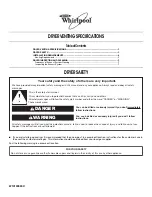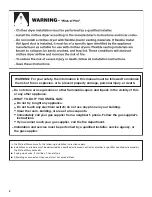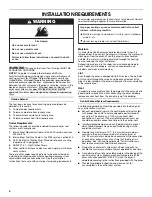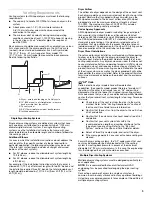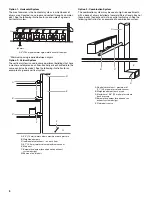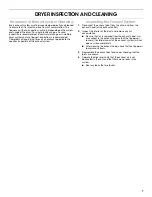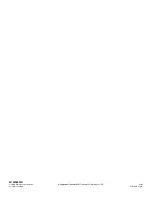
4
INSTALLATION REQUIREMENTS
WARNIN
G
Fire Hazar
d
Use a heavy metal vent.
Do not use a plastic vent.
Do not use a metal foil vent.
Failure to follow these instructions can result in
d
eath
or fire.
WARNING:
To reduce the risk of fire, this dryer MUST BE
EXHAUSTED OUTDOORS.
NOTE:
This guide is intended to aid licensed HVAC or
Architectural Engineers who design single and multi-dryer unit
venting systems for Whirlpool Corporation dryers sold in the
United States. Whirlpool Corporation provides required airflow
and back pressure specifications, measured at the connection
between the vent system and the dryer’s vent pipe, for use in the
design of dryer vent systems. Whirlpool does not design multi-
dryer vent systems, nor does Whirlpool review or provide
approvals for vent systems designed by third-party engineering
firms.
Outsi
d
e Exhaust
The four basic reasons for exhausting a dryer outdoors are
detailed in this section:
1.
To meet codes requirements.
2.
To remove moisture from laundry area.
3.
To avoid lint accumulation in laundry area.
4.
To remove excess heat from laundry area.
Co
d
es Requirements
The following codes should be reviewed to ensure dryer vent
systems are in compliance:
1.
International Mechanical Code: In the 2000 version, sections
504 and 913.
2.
International Fuel
G
as Code: In the 2003 version, section 614.
3.
UL 2158 Electric Clothes Dryer Standard references venting
requirements in paragraph 7.3.
4.
ANSI Z21.5.1 -
G
as Clothes Dryers.
5.
Other sections of these codes may also apply to multi-dryer
vent systems.
There are other codes requiring dryers to be exhausted when
installed in confined spaces where specified clearances from
combustible surfaces cannot be met. See the Installation
Instructions that came with your dryer for spacing requirements.
Local codes and ordinances that exist must also be met. Consult
your local building inspector for more information.
Improper ventin
g
can cause moisture and lint to collect
indoors, which may result in:
Moi
s
ture damage to woodwork, furniture, paint, wallpaper,
carpet
s
, etc.
Hou
s
ecleaning problem
s
and health problem
s
.
Moisture
A normal towel load contains some residual water when it is
removed from the washer. The dryer must remove this water and
discharge it from the drum. When the dryer is not exhausted
outside, this moist air will be recirculated through the heating
source, reducing the dryer’s efficiency.
Exhausting moisture into the room can also cause damage to
walls, floors, picture hangers, and cause condensation on
windows and walls in cold weather.
Lint
Even though the dryer is equipped with a lint screen, fine particles
of lint can get through the screen and be exhausted out of the
dryer. Proper venting of the dryer will keep lint from accumulating
in the laundry area.
Heat
In order to remove moisture from the garments in the dryer, heat is
generated to vaporize the water. Exhausting the dryer outdoors
removes excess heat from the laundry area of the building.
Central Exhaust System Requirements
The following guidelines should be considered in the design of
any central exhaust system:
■
Exhaust individual dryers to the central exhaust duct system
with proper size vents to assure adequate performance of
each dryer. The dryer has 4" (102 mm) exhaust duct
connections. Four inch (102 mm) diameter aluminum vent
should be used to connect each dryer to the central vent.
■
Install weighted dampers on each individual dryer exhaust
duct. These dampers may be used for balancing out the
overall duct system.
■
Provide for a maximum of 0.1" (2.5 mm) of water column
vacuum in the central exhaust duct and a maximum of
0.6" (15 mm) of water column back pressure at the connection
of each dryer exhaust vent at any time that the dryer is in
operation. See “Venting Requirements” for instructions on
how to measure water column back pressure.
■
Design the central duct system for sufficient capacity to
handle the maximum number of dryers operated at one time.
■
Consider moisture, lint and air temperature in the design of the
central duct system. Maximum exhaust temperature of the
dryer will not exceed 200°F (93.3°C) when the dryer is
operated according to the instructions provided with the dryer.
■
Provide for periodic inspection and clean-out of lint
accumulated in the central duct system.

